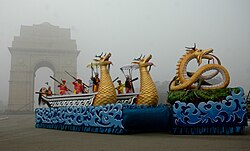Story
Keibu Keioiba was a human in the daytime and a tiger at night. During night, he prowled around looking for food. One night, he found an older woman's house and planned to devour her. The old woman said that her wrinkled skin would not be tasty and suggested that he eat a beautiful and young woman named Thabaton instead. Thabaton was the only sister in a family with seven brothers. The old woman told Keibu Keioiba that her brothers had gone for a work and that Thabaton was alone. The old woman helps Keibu Keioiba to trick Thabaton into opening the door to her house and succeeded in making Thabaton. Keibu Keioba kidnaps Thabaton. [9]
Shortly after this, Thabaton's brothers return home from work [10] and discover that Thabaton is missing. They ask the old woman about their sister, and she tells them about Keibu Keioiba. The seven brothers prepare their weapons and set out in search of their sister. Keibu Keioiba has not eaten Thabaton. Instead, he has forced Thabaton to become his wife, and they live together in the forest. The brothers never stop searching for their sister. One day, they see Thabaton. When they get close to her, they see that she is with a man and has a baby with her. The brothers discreetly signal to Thabaton so that she knows they have arrived. When Keibu Keioiba goes away for a hunt, Thabaton meet her brothers and they plan her escape. [9] : 76
When Keibu Keioiba returns, Thabaton gives him a hollow utong (bamboo pipe) open at both ends. She tells Keibu Keioiba to fetch water from the stream with the utong. In Keibu Keioiba's absence, the brothers burn down Keibu Keioiba's house, kill the baby, and run away with their sister. [9] : 77 On the other hand, Keibu Keioiba could not collect water with the utong; when he tried, the water leaked. A crow, observing his activities from a treetop mocked his foolishness. Keibu Keioiba returns home to find his son dead, his wife missing, and his house burnt to the ground. His anger knew no bounds. He charges back to the home of Thabaton and her brothers, who have prepared their weapons. As soon as Keibu Keioiba approaches them, they attack. Finally, Keibu Keioiba dies at the hands of the Thabaton's seven brothers. Thabaton and her seven brothers live happily ever after. [9] : 78 [10] : 59
This page is based on this
Wikipedia article Text is available under the
CC BY-SA 4.0 license; additional terms may apply.
Images, videos and audio are available under their respective licenses.



